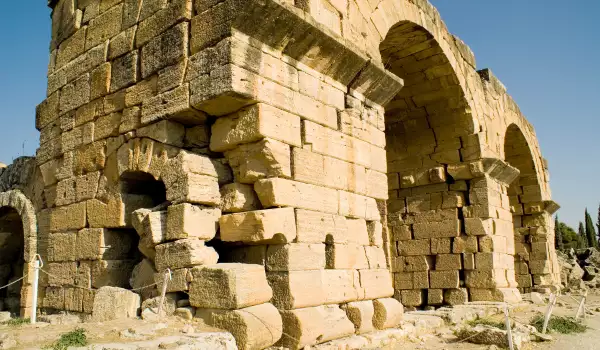Hierapolis

The amazing forms of the famous landmark Pamukkale are intrinsically linked to the ancient city Hierapolis. Hierapolis is located in southwestern Turkey, about 225 km from Marmaris and can be visited within a day’s trip. The ruins of Hierapolis and Pamukkale are located 22 km northeast of the city of Denizli.
The beauty of these two sites make them one of the wonders of the world (according to some eighth), which is protected by UNESCO in 1988 , and included in the List of World Cultural and Natural Heritage Sites. Today, this Turkish territory that has no equivalent worldwide is known as the National Park Hierapolis-Pamukkale.

Hierapolis is known as the ancient town of healing waters. Water streams from the ancient city Hierapolis are rich in mineral salts, falling from a great height, creating strange, petrified, dazzling white cascades. To arrive at Pamukkale we must pass the stone streets and ruins of the ancient city. In translation from Greek Hierapolis means "holy city".
Supposedly, it was founded in the early second century BC as a spa center. The exact date is mentioned as 190 BC and for its founders - Atalidite dynasty, rulers of Pergamon. Hierapolis was very popular among the Romans, suffering from skin diseases and rheumatism. The city is named Hiera which was wife of Telefos, son Hercules.
In 133 BC the city is already within the Roman Empire, And 1-2 century marked the most important moments in history. Two strong Earthquakes - Over 17 years and in 60 years destroyed much of the ancient Greek settlement, the second earthquake proved fatal to fate of Hierapolis.
By order of the Emperor Nero, the city was rebuilt on the same site and was then much larger and more magnificent. There are wide streets, theater, public baths and houses, supplied with hot water, which passed through a special sanitation.
The great amphitheater in Hierapolis was built in 129 in honor of the visit of Emperor Hadrian. At that time, the village is now a famous spa center - thousands of people come here to be treated, causing intense construction of buildings. There are baths, Gymnasium, several temples, a main street with colonnades, and fountains of mineral water.
Outside the city walls is a spacious cemetery with 1200 massive and ornate tombs. After 370, Hierapolis became a part of Byzantium, but its importance is not reduced. In the seventh century, the town was destroyed by the Persians and another earthquake. In the following centuries the city was recovering in parts, but in the 12 century, after the invasion of Seljuk, in only 2 centuries, Hierapolis is depopulated.
Today, one of the remarkable historic monuments Hierapolis is the partly preserved Roman theater, the Christian basilica, Temple of Apollo, Arch of Domitian, the Roman resort with mineral springs, and a vast necropolis. They were discovered after archeological excavations began in 1957.
The main street of the city is 1500 meters long and wide 13, 5 m. It is oriented north-south and begins and ends with arches with columns. Even today, the old town is not fully revealed.
Undoubtedly the most impressive building in Hierapolis was the amphitheater, which has a capacity of 15, 000 seats, located on a total of 45 rows. Today, however, we have managed to maintain only 30 rows.
In 352, the amphitheater was rebuilt with the possibility of aquatic performances. Interesting are the Roman baths, part of which is now turned into an archaeological museum.






